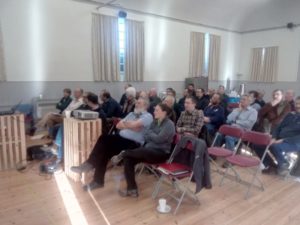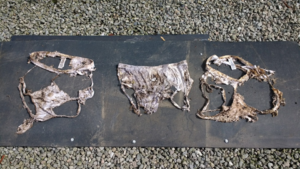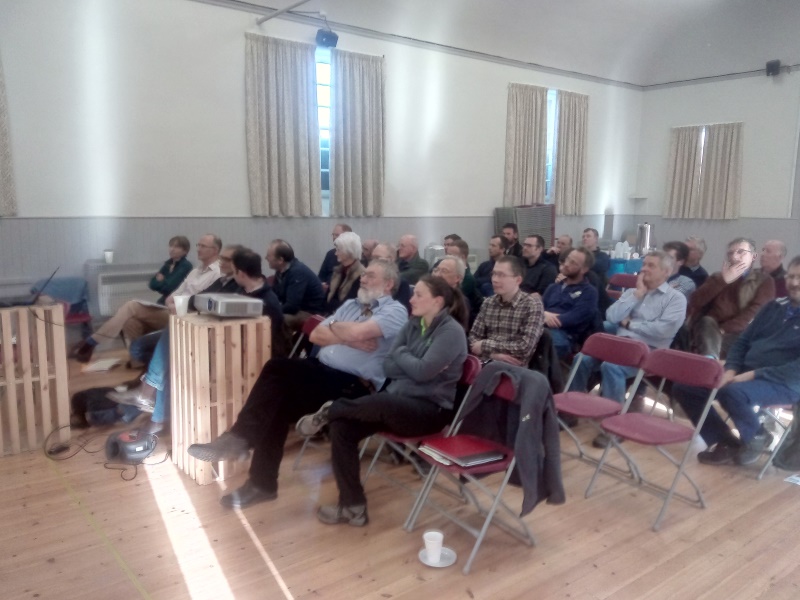East Lothian & Berwickshire Soil & Nutrient Network Farm: 2nd meeting event summary
12 February 2019This was the second meeting of the East Lothian & Berwickshire Soil & Nutrient Network and the focus was on ‘soil organic matter and organic manures’.
Donald Dunbar, SAC Consulting, opened the event with a review of the soil health tests that had been undertaken at Bielgrange. This set the scene for the remainder of the meeting with the other guest speakers.
Ian Bingham, SRUC Crop Research, gave a detailed presentation covering nitrogen, explaining that all crops need an input of fertilizer to yield well and to meet market requirements, but some are more efficient than others. These are some data comparing N use on farm in the UK. Sugar beet and potatoes are more efficient than cereals at both capturing N and also converting it to yield. So we need to try and improve that. Not only do crops types differ, there is huge variation in the NUE between sites and years. Ian then went on to discuss the cereal crop demand and how we can influence the Nitrogen Use Efficiency of plants, with particular reference to trail works undertaken looking at oats and barley.
Ian’s take-home messages are:
- cereal crop demand for nitrogen is from early spring growth to stem extension, then it declines.
- Recent trial work has shown that plant breeding has selected varieties that have better nitrogen uptake and utilisation.
- Oats are more efficient than other cereals at extracting nitrogen from the soil and is a reason why nitrogen recommendations are 30kgN less than barley.
- AHDB spring barley project showed highest yield came from split application of nitrogen between seedbed and 3rd leaf emerged.
- Trial results in spring barley show that grain nitrogen content is being diluted by higher yielding varieties.
Audrey Litterick, Earthcare Technical, was next to take the floor. Audrey’s presentations focused on the importance of organic matter in soil and the benefits of bulky organic  fertilisers e.g. dungs, slurries, digestates, biosolids, and composts. Audrey stressed the importance of soil organic matter (SOM), citing that “We now know that soil organic matter is vitally important if we are to have healthy, functional soils”, explaining that soils with a higher SOM are more resilient, primarily because they tend to have better soil structure. Ways in which the SOM can be increased is to incorporate more bulky organic manures; growing green manures or cover crops which are then incorporated into the soil; undertake min-till or no-till management to prevent soil damage and/or by reducing losses by minimising intensive cultivations and choosing not to grow crops where cultivations or harvest are likely to result in soil damage. For the second part of her presentation, Audrey expanded on the benefits of bulky organic manures such as slurries, dungs, digestates, composts, and biosolids as fertilisers and soil conditioners. Testing your manure is critical to knowing exactly what you are applying as a nutrient, It is important that nutrients applied meet crop demand and Audrey encouraged the use of free to download and use software programmes to help with this (Planet/Manner). Application methods and timings can also impact the nutrient value available to your crops; this was demonstrated by looking briefly at a recent piece of research undertaken to look at ammonia losses from the use of broad spreading; trailing shoe and shallow injection applications. As the Scottish Government are reviewing the Clean Air Strategy for Scotland, it is anticipated that farmers will face a greater focus on reducing their ammonia emissions – carefully considering liquid organic fertiliser applications will be one way that the emissions can be reduced. The benefit of such reductions of ammonia will mean an increased availablity of Nitrogen for use by the crop.
fertilisers e.g. dungs, slurries, digestates, biosolids, and composts. Audrey stressed the importance of soil organic matter (SOM), citing that “We now know that soil organic matter is vitally important if we are to have healthy, functional soils”, explaining that soils with a higher SOM are more resilient, primarily because they tend to have better soil structure. Ways in which the SOM can be increased is to incorporate more bulky organic manures; growing green manures or cover crops which are then incorporated into the soil; undertake min-till or no-till management to prevent soil damage and/or by reducing losses by minimising intensive cultivations and choosing not to grow crops where cultivations or harvest are likely to result in soil damage. For the second part of her presentation, Audrey expanded on the benefits of bulky organic manures such as slurries, dungs, digestates, composts, and biosolids as fertilisers and soil conditioners. Testing your manure is critical to knowing exactly what you are applying as a nutrient, It is important that nutrients applied meet crop demand and Audrey encouraged the use of free to download and use software programmes to help with this (Planet/Manner). Application methods and timings can also impact the nutrient value available to your crops; this was demonstrated by looking briefly at a recent piece of research undertaken to look at ammonia losses from the use of broad spreading; trailing shoe and shallow injection applications. As the Scottish Government are reviewing the Clean Air Strategy for Scotland, it is anticipated that farmers will face a greater focus on reducing their ammonia emissions – carefully considering liquid organic fertiliser applications will be one way that the emissions can be reduced. The benefit of such reductions of ammonia will mean an increased availablity of Nitrogen for use by the crop.
Audrey’s take home messages are:
- Little and often applications of manures and wastes are the best way to a healthy soil
- Slurries are high in water and available nutrients; more like a fertiliser
- FYM provides slow release nitrogen and greater organic matter and soil conditioning benefits
- Green and other fibre wastes are higher in organic and good soil conditioners
- Like a fertiliserFYM provides slow release nitrogen and greater organic matter and soil conditioning benefitsGreen and other fibre wastes are higher in organic and good soil conditioners
- Test a representative sample (see our video here)
- Analysis needs to include dry matter, organic matter, total nitrogen and available nitrogen, major and trace nutrients
- Calculate % readily available nitrogen (RAN), value of major nutrients and other nutrients important to you
The final guest speaker was Donald Ross, Scottish Arable Farm of the year. Donald gave an interesting introduction to his farming business – he farms a 280ha mixed arable farm 35 miles north of Inverness in Easter Ross, comprising of 175 ha arable, 45 ha permanent grass, 29 ha woodland and 2 SSSI’s. The rotations are OSR / WW / SO / WW / tatties / WW/ SB / SB (+ 2nd wheat) and some rotational grass. Soils on the farm are variable, the main part is Cromarty series derived from Old Red Sandstone, a sandy loam with  a percentage of clay thrown in for good measure soil depths vary from 25cm to over 1m. On the permanent grazing which is on flat land there is a high percentage of peat with a marl or blue clay which makes life interesting, Drainage is a constant battle due to the high levels of iron in the soil. There are 4 different drainage schemes in this field 3 in his lifetime. It is necessary to jet the drains annually due to the amount of iron in the soil. Soil management typically includes managing soil pH, compaction and monitoring the soil organic matter. Recently the farm undertook the #SoilMyUndies experiment to get a feel for what the soil organic matter was, with pleasing results!
a percentage of clay thrown in for good measure soil depths vary from 25cm to over 1m. On the permanent grazing which is on flat land there is a high percentage of peat with a marl or blue clay which makes life interesting, Drainage is a constant battle due to the high levels of iron in the soil. There are 4 different drainage schemes in this field 3 in his lifetime. It is necessary to jet the drains annually due to the amount of iron in the soil. Soil management typically includes managing soil pH, compaction and monitoring the soil organic matter. Recently the farm undertook the #SoilMyUndies experiment to get a feel for what the soil organic matter was, with pleasing results!
After the overview of Rhynie Farm, Donald proceeded to explain the Yield Enhancement Network (YEN). The Yield Enhancement Network a group of like minded farmers spread from Shetland to Cornwall and abroad to Switzerland, Denmark Ireland and even Canada.
Its aim is to identify arable innovators and support their innovating. YEN is a competition where participants grow a cereal crop or Oilseed Rape, we enter the competition send a soil sample in and try their best to get a good yield. Samples of the grain and the straw are analysed and a large report is returned which has everything from weather details, available light energy size of grain and numerous other statistics. Part of the Network is to study the growth of our crops, check sowing depth, rooting depth as the deeper the rooting the more chance of enhancing the yield and resilience of the crop. Improving the biomass both above and below the soil.
David continued with the benefits of being part of the YEN, such as a study trip to Europe and a conference during the winter which provides a great networking opportunity. More details on YEN can be found at www.yen.adas.co.uk/. His top tips for YEN success are:
Recipe to YEN success
- Choose the correct field (use a drone)
- Soil sample
- Count plants
- Apply inputs little and often
- Tissue test for nutrient shortage in season
- Keep disease free
Information related to the topics covered during the event are available to download from the links at the bottom of this page.
Bielgrange is one of twelve host farms for the Soil & Nutrient Network. You can read about the other farms and what has been discussed at their meetings on our webpage.
- Practical Guide – Optimising Organic Nitrogen
- This Practical Guide concentrates on how you can manage organic nitrogen to benefit the business and help reduce GHG emissions.
- Topics: Climate Change, Soils and Water Management
- Farming For A Better Climate: Practical Guide – Improving Soil Quality
- This Practical Guide concentrates on how we can improve soil quality to help us to adapt to climate change.
- Topics: Soils
- Farming For A Better Climate: Practical Guide – Soil Management
- Topics: Soils
- GAEC 6 – Maintenance of soil organic matter
- The aim of GAEC 6 rules is to maintain soil organic matter levels.
- Topics: Rural Business
- Technical Note (TN699): Agricultural use of Biosolids, Composts, Anaerobic Digestates and other Industrial Organic Fertilisers
- Organic fertilisers such as biosolids, composts, anaerobic digestates and industrial wastes can be useful and cost-effective crop nutrient sources that can improve soil quality. This technical note outlines their use in agriculture.
- Topics: Climate Change, Soils and Water Management
- Valuing Your Soils – Practical Guidance for Scottish Farmers
- This brochure includes useful information about Scotland's agricultural soils and practical advice outlining the upfront financial savings and business benefits of better soil management and the efficient use of resources. Action and problem-specific 'field-sheets' are designed for busy farmers with limited time for reading.
- Topics: Climate Change, Soils, Water Management and Crops and Soils
Sign up to the FAS newsletter
Receive updates on news, events and publications from Scotland’s Farm Advisory Service

